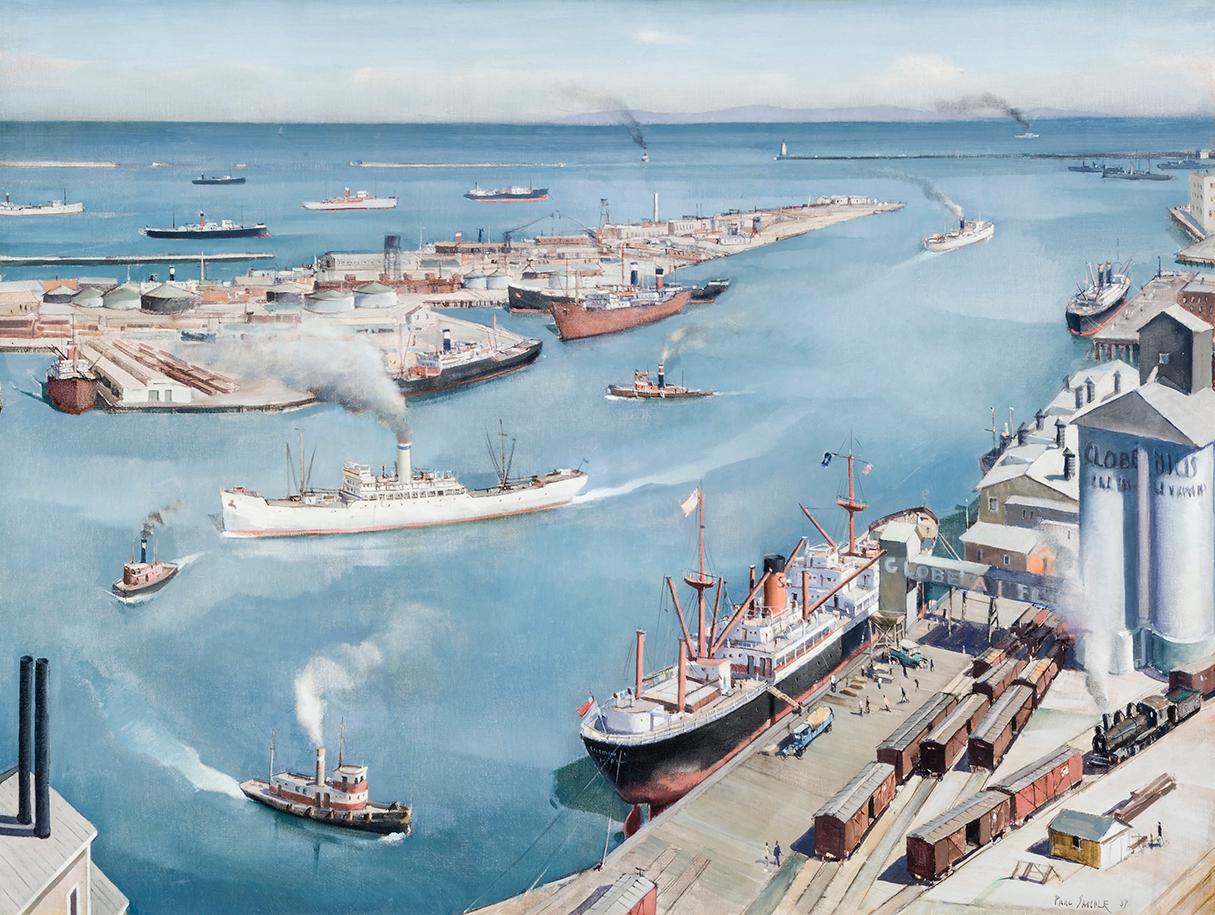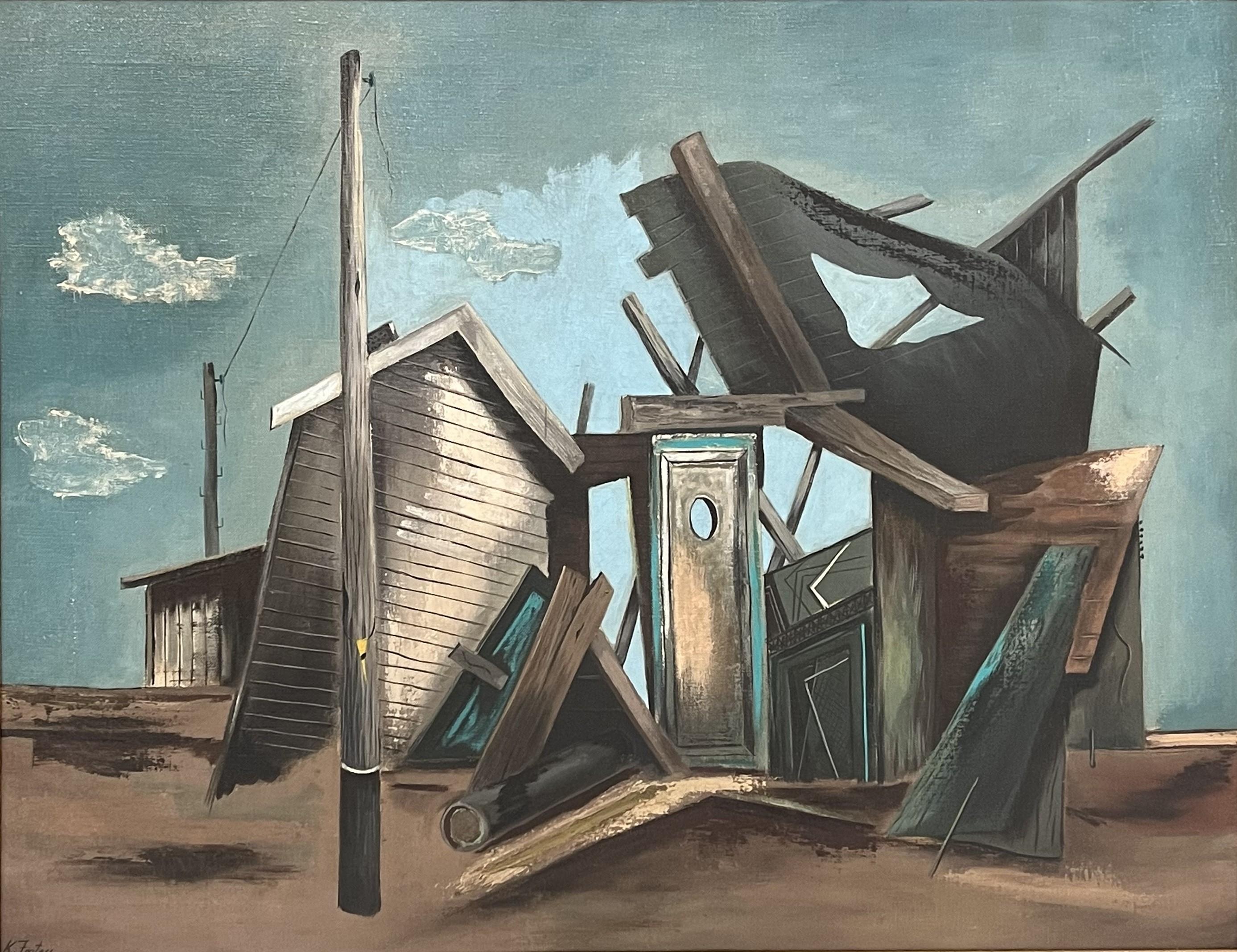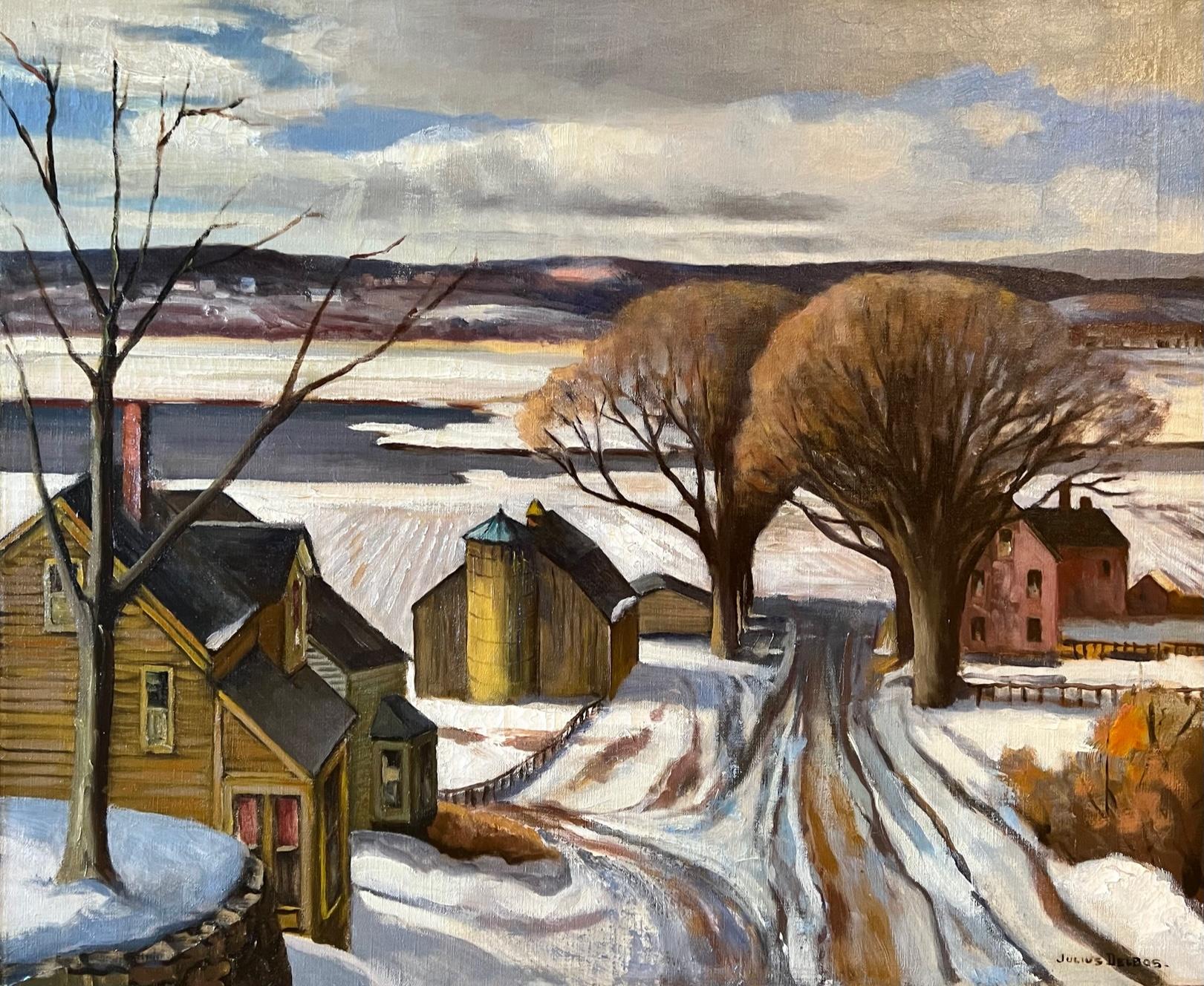Items Similar to "Yellow Sky" Oil on Canvas by Jerome Gastaldi #2
Want more images or videos?
Request additional images or videos from the seller
1 of 11
Jerome Gastaldi"Yellow Sky" Oil on Canvas by Jerome Gastaldi #22005
2005
About the Item
This painting features a yellow sky (as Gastaldi named it) and it is part of 3. The #1 one is featuring a red sky and the third one is the desert light.
#1 and 2 show the strength of nature with vigorous large brush strokes and bright colors whereas the colors of #3 depicting the desert light, are more muted and reflect perfectly the desert atmosphere before a storm.
See, attached the pictures of the 2 matching ones.
Jerome Gastaldi, born in Oakland, California, in 1945, is a contemporary artist.
His works have been compared by art critics to that of Robert Rauschenberg, Edward Kienholz, and Francis Bacon. His creative process is both emotional and intuitive, as evidenced by Gastaldi’s rapid handling of paint.
His paintings are powerful that express the immediacy, movement, and timelessness of his subjects, which are predominantly landscapes. The seductive colors and fierce strength of nature seem to lure the spectator into his realm.
Gastaldi works in a number of media, including painting, filmmaking, sculpture, printmaking, ceramics, and performance.
His work has been exhibited internationally in museums, universities, and other public institutions, as well as held in public, private and corporate collections.
- Creator:Jerome Gastaldi (1945, American)
- Creation Year:2005
- Dimensions:Height: 30 in (76.2 cm)Width: 30 in (76.2 cm)Depth: 1.5 in (3.81 cm)
- Medium:
- Movement & Style:
- Period:
- Framing:Frame IncludedFraming Options Available
- Condition:Framing is not needed, the artist painted the sides of the piece in blue-grey color.
- Gallery Location:Pasadena, CA
- Reference Number:1stDibs: LU654311326172
About the Seller
5.0
Vetted Seller
These experienced sellers undergo a comprehensive evaluation by our team of in-house experts.
Established in 1999
1stDibs seller since 2017
51 sales on 1stDibs
Typical response time: 11 hours
- ShippingRetrieving quote...Ships From: Pasadena, CA
- Return PolicyA return for this item may be initiated within 3 days of delivery.
More From This SellerView All
- "The Arno" Italian Village by the River Oil Painting by Bruce McCrackenLocated in Pasadena, CAThis oil painting from the 65s by California Artist Bruce McCracken derives its title and inspiration from the mythical Arno River in Tuscany. Dividing the historic city of Florence into two distinct parts, the Arno has long captivated the collective imagination and continues to be a subject of exploration for many contemporary artists. Set against the backdrop of the Arno's picturesque banks, the artist likely sought inspiration from the vantage point of the Ponte Vecchio (Old Bridge) in Florence. The painting is divided into two distinct horizons. The upper section showcases architectural buildings poised upon a medieval arch...Category
1960s American Modern Landscape Paintings
MaterialsBoard, Oil
- "Duck Lake" California Expressionist Oil Landscape by John Mitchell MartinLocated in Pasadena, CAThis oil painting features a calm lake where eleven black ducks swim. The artist painted a water pipe on the lake's left bank while a palm tree stands alone at the center. John Mit...Category
20th Century Expressionist Figurative Paintings
MaterialsCanvas, Oil
- "Iron Bridge" Large Oil Painting on Canvas 1989 by Paul WeingartenLocated in Pasadena, CAThe artwork features a red bridge above a narrow river. A tiny boat passes by, between the two huge structures holding the bridge on each side. Depicting an industrial environment, the artist gave the overall impression of a middle ground between nature and technology. Paul Weingarten is an American Postwar & Contemporary painter. Paul Weingarten received a BS in Art at New York University and studied at The Art Students League and Columbia University, where he enrolled in the MA program. He has taught studio art in Connecticut and New York public school programs at the New York Studio School, the University of Wisconsin, and Binghamton University (SUNY). He has recently held solo exhibitions at Salander-O’Reilly Galleries, the Montclair Art Museum; the State Museum, Trenton, NJ; and the Cathedral of St. John the Divine, NY, among others. He participated in group shows at the Hudson River Museum...Category
21st Century and Contemporary Contemporary Landscape Paintings
MaterialsCanvas, Oil
- "Downtown San Francisco" Cityscape Acrylic Abstract by Charles HamiltonBy Charles HamiltonLocated in Pasadena, CAIn this painting by Charles Jupiter Hamilton's "Downtown San Francisco," the pulsating heartbeat of the city comes alive in a kaleidoscope of color and form. This acrylic abstract se...Category
Mid-20th Century Abstract Geometric Landscape Paintings
MaterialsCanvas, Oil
- "Parisian Street", Cityscape Oil on Canvas by Robert FarringtonLocated in Pasadena, CAThis Robert Farrington's painting serves as a visual gateway to a distinct period in post-war France, composed with a deep respect for the elements interwoven into the collective memory of Paris. His work adeptly engages with the archetypal settings and concepts that convey the quintessence of this beloved and frequently visited capital. As the viewer gazes upon this artwork, they are instantly immersed in the ambiance of a food trade street, and especially the familiar historic brasserie “Au Pied de Cochon” - the sole establishment in the painting that still exists nowadays - and its surroundings at the heart of the bustling Halles district. At "6 Rue Coquillère", the act of opening the doors, each adorned with handles that resemble pig's trotters, transports one through a temporal gateway into the quintessential French world of "la cochonnaille"... The renowned "Pied de Cochon" restaurant made its debut in 1947. In its early days, it became the preferred gathering place for the "Forts des Halles" – the diligent laborers who tirelessly transported goods through the pavilions of the old Halles de Paris. From these dedicated workers to the luminaries of the time, this establishment emerged as a symbol of Parisian life. Farrington reconstructs a scene around this restaurant, nourished by her own Parisian experience when he was a young American living in France. An iconic Brigitte Bardot poster...Category
Late 20th Century Post-Impressionist Landscape Paintings
MaterialsCanvas, Oil
- "Embankment of the Seine River" Parisian Cityscape Oil Painting by Pierre GiraudLocated in Pasadena, CAPierre Giraud's "Embankment of the Seine River" Parisian cityscape, portraying the iconic Pont au Change bridge, offers a mesmerizing scene at dusk. A m...Category
Mid-20th Century Impressionist Landscape Paintings
MaterialsOil, Canvas
You May Also Like
- San Pedro HarborBy Paul SampleLocated in New York, NYIt is infrequent, to say the least, that a diagnosis of tuberculosis proves fortuitous, but that was the event, in 1921, that set Paul Starrett Sample on the road to becoming a professional artist. (The best source for an overview of Sample’s life and oeuvre remains Paul Sample: Painter of the American Scene, exhib. cat., [Hanover, New Hampshire: Hood Museum of Art, 1988] with a detailed and definitive chronology by Sample scholar, Paula F. Glick, and an essay by Robert L. McGrath. It is the source for this essay unless otherwise indicated.) Sample, born in Louisville, Kentucky, in 1896 to a construction engineer and his wife, spent his childhood moving with his family to the various locations that his father’s work took them. By 1911, the family had landed in Glencoe, Illinois, settling long enough for Paul to graduate from New Trier High School in 1916. Sample enrolled at Dartmouth College, in Hanover, New Hampshire, where his interests were anything but academic. His enthusiasms included the football and basketball teams, boxing, pledging at a fraternity, and learning to play the saxophone. After the United States entered World War I, Sample, to his family’s dismay, signed on for the Naval Reserve, leading directly to a hiatus from Dartmouth. In 1918 and 1919, Sample served in the U.S. Merchant Marine where he earned a third mate’s license and seriously contemplated life as a sailor. Acceding to parental pressure, he returned to Dartmouth, graduating in 1921. Sample’s undergraduate life revolved around sports and a jazz band he formed with his brother, Donald, two years younger and also a Dartmouth student. In November 1933, Sample summarized his life in a letter he wrote introducing himself to Frederick Newlin Price, founder of Ferargil Galleries, who would become his New York art dealer. The artist characterized his undergraduate years as spent “wasting my time intensively.” He told Price that that “I took an art appreciation course and slept thru it every day” (Ferargil Galleries Records, circa 1900–63, Archives of American Art, Smithsonian Institution, available on line). In 1920, Donald Sample contracted tuberculosis. He went for treatment to the world-famous Trudeau Sanitorium at Saranac Lake, in New York State’s Adirondack Mountains for the prescribed regimen of rest, healthful food, and fresh air. Visiting his brother in 1921, Paul also contracted the disease. Tuberculosis is highly contagious, and had no certain cure before the development of streptomycin in 1946. Even for patients who appeared to have recovered, there was a significant rate of recurrence. Thus, in his letter to Price, Sample avoided the stigma conjured by naming the disease, but wrote “I had a relapse with a bad lung and spent the next four years hospitalized in Saranac Lake.” The stringent physical restrictions imposed by adherence to “the cure” required Sample to cultivate an alternate set of interests. He read voraciously and, at the suggestion of his physician, contacted the husband of a fellow patient for instruction in art. That artist, then living in Saranac, was Jonas Lie (1880–1940), a prominent Norwegian-American painter and an associate academician at the National Academy of Design. Lie had gained renown for his dramatic 1913 series of paintings documenting the construction of the Panama Canal (The Metropolitan Museum of Art, New York; United States Military Academy, West Point, New York). Primarily a landscape artist, Lie had a particular affinity for scenes with water. His paintings, impressionistic, atmospheric, and brushy, never strayed from a realistic rendering of his subject. Sample regarded Lie as a mentor and retained a lifelong reverence for his teacher. Sample’s early paintings very much reflect Lie’s influence. ` In 1925, “cured,” Sample left Saranac Lake for what proved to be a brief stay in New York City, where his veteran’s benefits financed a commercial art course. The family, however, had moved to California, in the futile hope that the climate would benefit Donald. Sample joined them and after Donald’s death, remained in California, taking classes at the Otis Art Institute in Los Angeles. In Sample’s account to Price, “I couldn’t stomach the practice of painting a lot of High Sierras and desert flowers which seemed to be the only kind of pictures that were sold here so I got a job teaching drawing and painting at the art school of the University of Southern California.” Initially hired as a part-time instructor, Sample progressed to full-time status and ultimately, by the mid-1930s, to the post of Chairman of the Fine Art Department. Sample, however, did not want to wind up as a professor. “Teaching is all right in small doses,” he wrote, “but I have a horror of drifting into being a college professor and nothing more.” At the same time as he taught, Sample began to exhibit his work in a variety of venues at first locally, then nationally. Though he confessed himself “a terrible salesman,” and though occupied with continued learning and teaching, Sample was nonetheless, ambitious. In 1927, he wrote in his diary, “I am eventually going to be a painter and a damned good one. And what is more, I am going to make money at it” (as quoted by Glick, p. 15). In 1928, Sample felt sufficiently solvent to marry his long-time love, Sylvia Howland, who had also been a patient at Saranac Lake. The Howland family were rooted New Englanders and in summertime the Samples regularly traveled East for family reunion vacations. While the 1930s brought serious hardship to many artists, for Paul Sample it was a decade of success. Buttressed by the financial safety net of his teacher’s salary, he painted realist depictions of the American scene. While his work addressed depression-era conditions with a sympathetic eye, Sample avoided the anger and tinge of bitterness that characterized much contemporary realist art. Beginning in 1930, Sample began to exhibit regularly in juried exhibitions at important national venues, garnering prizes along the way. In 1930, Inner Harbor won an honorable mention in the Annual Exhibition of the Art Institute of Chicago. That same year Sample was also represented in a show at the Albright-Knox Gallery in Buffalo and at the Biennial Exhibition of the Corcoran Gallery of Art, Washington, D.C. In 1931, Dairy Ranch won the second Hallgarten Prize at the Annual Exhibition of the National Academy of Design, in New York. Sample also made his first appearances at the Carnegie Institute, Pittsburgh, and The Pennsylvania Academy of the Fine Arts, Philadelphia. In 1936, Miner’s Resting won the Temple Gold Medal at the Pennsylvania Academy’s Annual Exhibition. Always interested in watercolor, in 1936, Sample began to send works on paper to exhibitions at the Whitney Museum, New York. While participating in juried exhibitions, Sample also cultivated commercial possibilities. His first New York art dealer was the prestigious Macbeth Gallery in New York, which included his work in a November 1931 exhibition. In 1934, Sample joined the Ferargil Galleries in New York, after Fred Price arranged the sale of Sample’s Church Supper to the Michele and Donald D’Amour Museum of Fine Arts in Springfield, Massachusetts. In 1937, The Metropolitan Museum of Art purchased Sample’s Janitor’s Holiday from the annual exhibition of the National Academy of Design, a notable honor. As prestigious as this exhibition schedule may have been, by far Sample’s most visible presence in the 1930s and 1940s was the result of his relationship with Henry Luce’s burgeoning publishing empire, Time, Inc. Sample’s first contribution to a Luce publication appears to have been another San Pedro...Category
20th Century American Modern Landscape Paintings
MaterialsCanvas, Oil
- The Old Monastery WallBy William S. SchwartzLocated in New York, NYSigned (at lower left): WILLIAM S. SCHWARTZCategory
Early 20th Century American Modern Landscape Paintings
MaterialsCanvas, Oil
- LandscapeBy Marcel Emile CaillietLocated in Los Angeles, CALandscape, 1940, oil on canvas, 24 x 20 inches, signed, dated and titled verso: “Marcel Cailliet ’40 – S.C.” and “Marcel Cailliet Landscape”; likely exhibited at the annual juried st...Category
1940s American Modern Paintings
MaterialsCanvas, Oil
- Untitled (Collapsed Shacks)By Karl FortressLocated in Los Angeles, CAUntitled (Collapsed Shacks), c. 1940s, oil on canvas, signed lower left, 20 ½ x 26 ½ inches, presented in a period frame This work is part of our exhibition America Coast to Coast: ...Category
1940s American Modern Paintings
MaterialsCanvas, Oil
- Untitled (Farm in Winter)By Julius M. DelbosLocated in Los Angeles, CAThis work is part of our exhibition America Coast to Coast: Artists of the 1940s Untitled (Farm in Winter), 1940s, oil on canvas, signed lower right, 26 x 30 inches, presented in an original frame Julius Delbos...Category
1940s American Modern Paintings
MaterialsCanvas, Oil
- 1927 Oil Painting Eiffel Tower Paris American Modernist Wpa Artist Morris KantorBy Morris KantorLocated in Surfside, FLMorris Kantor New York (1896 - 1974) Paris from the Ile St. Louis, 1927 (view of Eiffel Tower) Oil painting on canvas Hand Signed lower left. Provenance: Hirshhorn Museum and Sculpture Garden, Smithsonian Institution ( bears label verso) Size: 20 3/4"H x 28 1/8"W (sight), 28.75 "H x 36"W (framed) Morris Kantor (Belarusian: Морыс Кантор) (1896-1974) was a Russian Empire-born American painter based in the New York City area. Born in Minsk on April 15, 1896, Kantor was brought to the United States in 1906 at age 10, in order to join his father who had previously relocated to the states. He made his home in West Nyack, New York for much of his life, and died there in 1974. He produced a prolific and diverse body of work, much of it in the form of paintings, which is distinguished by its stylistic variety over his long career. Perhaps his most widely recognized work is the iconic painting "Baseball At Night", which depicts an early night baseball game played under artificial electric light. Although he is best known for his paintings executed in a realistic manner, over the course of his life he also spent time working in styles such as Cubism and Futurism, and produced a number of abstract or non-figural works. A famous cubist, Futurist, painting of his "Orchestra" brought over 500,000$ at Christie's auction house in 2018 Kantor found employment in the Garment District upon his arrival in New York City, and was not able to begin formal art studies until 1916, when he began courses at the now-defunct Independent School of Art. He studied landscape painting with Homer Boss (1882-1956). In 1928, after returning to New York City from a year in Paris, Kantor developed a style in which he combined Realism with Fantasy, often taking the streets of New York as his subject matter. He did some moody Surrealist Nude paintings and fantasy scenes. In the 1940's he turned towards figural studies. Later in his career, Kantor himself was an instructor at the Cooper Union and also at the Art Students League of New York in the 1940s, and taught many pupils who later became famous artists in their own right, such as Knox Martin, Robert Rauschenberg, Sigmund Abeles and Susan Weil...Category
1920s American Modern Landscape Paintings
MaterialsCanvas, Oil
Recently Viewed
View AllMore Ways To Browse
Yellow Sky Landscape
Large Sky Oil Painting
Oil On Canvas By Edward
Landscape Yellow Sky Oil
Desert Oil On Canvas
Francis Bacon Large
Desert Storm
Edward Francis Wells
2 Matching Painting
Edward Bacon
Rauschenberg Yellow
Edward Kienholz
Jerome Gastaldi
Dior 30
Old English Art
Ship Oil Painting Framed
French Post Impressionist Oil Paintings
Venice Landscape





